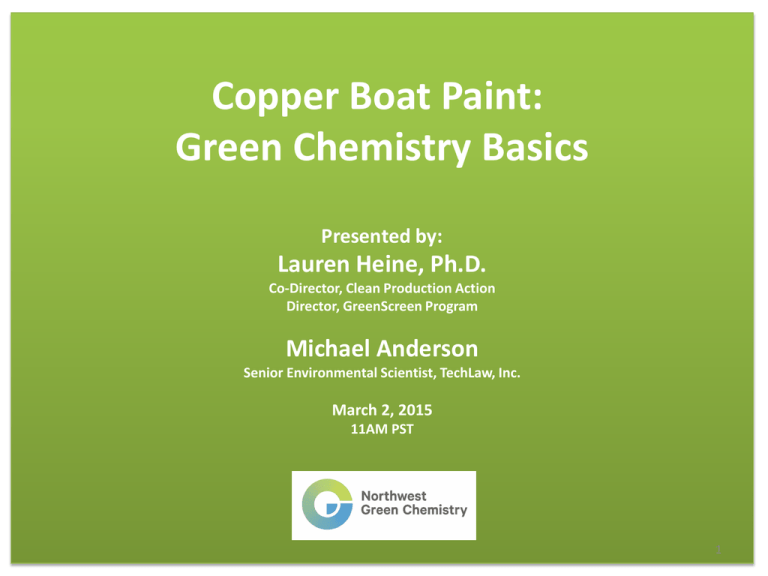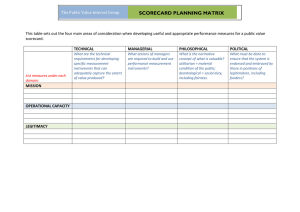Copper Boat Paint: Green Chemistry Basics
advertisement

Copper Boat Paint: Green Chemistry Basics Presented by: Lauren Heine, Ph.D. Co-Director, Clean Production Action Director, GreenScreen Program Michael Anderson Senior Environmental Scientist, TechLaw, Inc. March 2, 2015 11AM PST 1 Establishing a Center for Green Chemistry Mission: • Awarded an EPA National Estuary Program Grant as seed funding to develop an independent center by June 2016 “Enhance human and environmental health by fostering • Advisory board members from academia, industry, innovation and economic nongovernmental organizations, opportunities through sustainable and government. and green chemistry and engineering solutions.” 2 Northwest Green Chemistry Key Goals: • Create solutions for chemicals of concern in products and processes • Integrate and expand green chemistry into education and training • Inform and inspire market driven solutions and innovations • Help make the Northwest a leader in green chemistry and engineering 3 Copper Boat Paint’s Environmental Impacts • • • • Copper inhibits the olfactory sense of salmon Negative effects from low levels Deterioration of gills (decreased cardiovascular and nervous system function) Infection and death Photo courtesy of the Washington Dept. of Fish and Wildlife Copper toxicity is not limited to salmon. Copper is also toxic to other forms of aquatic life. 4 Regulatory Landscape History of Antifouling Paints • • • • First antifoulants included lime, arsenical and mercurial compounds, and DDT Tributyltin (TBT) came to prominence in the 1960s and was used on most ocean-going vessels by the 1970s TBT is toxic to most aquatic life and persistent in the marine environment In the 1980s, high concentrations of TBT were reported in coastal areas around the world 5 Regulatory Landscape Global TBT Regulation and Ban • • • • • 1988: the International Maritime Organization (IMO) gets involved 1999: IMO adopts an Assembly resolution urging governments to eliminate TBT-containing antifouling paints 2001: IMO adopted a new International Convention on the Control of Harmful Anti-fouling Systems on Ships, prohibiting the use of harmful organotins in antifouling paints used on ships 2008: The Convention entered into force 2014: Ratification by 69 countries (83% of the gross tonnage of the world’s merchant fleets) 6 Regulatory Landscape Copper Regulation Copper replaced TBT as the antifoulant of choice but also has negative environmental consequences. Washington State Boatyard from the 1990s. 7 Regulatory Landscape Copper Regulation • • • • Chapter 70.300 RCW, Recreational Water Vessels-Antifouling Paints, was passed by the Washington State Legislature in 2011, with the intent of phasing out the use of copper-based antifouling paints used on recreational water vessels. January 1, 2018: Sale of new vessels with copper antifouling paint banned January 1, 2020: Sale and application of antifouling paint containing more than 0.5% copper for recreational vessels banned Similar regulations are anticipated in other states and countries soon 8 Why We Need a Science of Safer Chemistry Reacting to Problems • regrettable substitution - Replacement of toxic chemical with chemical of equal or greater toxicity • Use of replacement chemicals with little data/unknown hazards 9 Green Chemistry “The design of chemical products and processes that reduce or eliminate the use and generation of hazardous substances” Hazard Exposure *Anastas, P.T.; Warner, J.C., Green Chemistry: Theory and Practice, Oxford University Press, 1998. 10 Keys to Green Chemistry 12 Principles of Green Chemistry 1. 2. 3. Prevent waste Maximize atom economy: Design less hazardous chemical syntheses: 4. Design safer chemicals and products: 5. Use safer solvents and reaction conditions 6. Increase energy efficiency 7. Use renewable feedstocks 8. Avoid chemical derivatives 9. Use catalysts, not stoichiometric reagents 10. Design chemicals and products to degrade after use 11. Analyze in real time to prevent pollution 12. Minimize the potential for accidents 11 Example Innovation- New Wood Glue Dr. Li, OSU 2007 Presidential Green Chemistry Award Winner Soy based adhesive competitive with a urea-formaldehyde resin 12 Alternative Assessment • A process for identifying and comparing potential alternatives (chemical and non-chemical) used as substitutes to replace chemicals or technologies of high concern Are the all the ingredients necessary? Are there safer ingredients? • What does one look at? Hazard, performance of chemical, cost/availability of material, exposure, materials management, social impact (environmental justice), life cycle 13 Scope of Existing Alternatives Categories of existing Alternatives: • • • Biocides essentially do the same thing that copper does – poison organisms Non-biocides provide a slick surface that greatly hinders attachment (soft) or a protective slick surface that can be cleaned aggressively (hard) Physical mechanisms prevent attachment without the use of chemicals or coatings 14 Scope of Existing Alternatives Primary Technologies on the Market Evaluated by NGC • Biocides-based paint – primarily zinc compounds and ECONEA® which are added to paint by manufacturers such as Interlux, Pettit, Seahawk, and ePaint • Foul release coatings – a soft biocide, usually siliconebased but includes other formulations; prevents attachment; developed by Fujifilm and Interlux or and even smaller companies like Aurora • Physical mechanisms - Ultrasonic sound (Ultrasonic) 15 Alternatives – Emerging Technologies Alternatives currently being developed: • Duke University - paint-like active polymer coating that dislodges fouling • University of Gothenburg in Sweden – Ivermectin formulations 16 Alternatives – Emerging Technologies Alternatives currently being developed: • Shaoyi Jiang, Professor of Chemical Engineering at the University of Washington has been working with Zwitterionic (ZI) polymers. Alternating charges in close proximity strongly attract water, leading to ultra low fouling surfaces. (courtesy of: www.zwittertech.com) • I-Tech – Swedish company, developers of Selektope® 17 The Scorecard Cleaning Up Puget Sound: Alternatives to Copper-based Antifouling Paints Scorecard (http://www.northwestgreenchemistry.org/scorecards.html) • Being developed to assist the boating community with selecting an alternative in anticipation of the new law banning copper antifouling boat paint use by 2020 for all recreational boats • Overall goal of reducing copper antifouling bottom paint as a source of water pollution to Puget Sound and eventually other Pacific Northwest waters • Avoid regrettable substitutions • Collaborative research effort based on information from manufacturers, boating industry representatives , and regulators. 18 The Scorecard Cleaning Up Puget Sound: Alternatives to Copper-based Antifouling Paints Scorecard (http://www.northwestgreenchemistry.org/scorecards.html) • Summarizes relevant information on some of the existing alternatives to copper antifouling bottom paint • Intended to be actionable, objective, and provide accessible information • A working document that will be updated as more brands adopt alternatives, paint formulations change, and as NGC gathers more information 19 The Scorecard Cleaning Up Puget Sound: Alternatives to Copper-based Antifouling Paints Scorecard (http://www.northwestgreenchemistry.org/scorecards.html) • Categories include: • • • • • How It Works Apparent Attributes Use/Versatility Unit Cost for Coverage Longevity • • • • • Application Method Compatibility with Existing Hull Paint VOCs content Active Ingredients Profiles – TBD / IC2 GSA Inert Ingredients Profiles – TBD / IC2 GSA 20 The Scorecard Cleaning Up Puget Sound: Alternatives to Copper-based Antifouling Paints Scorecard (http://www.northwestgreenchemistry.org/scorecards.html) • The Guidance for Criteria Evaluation explains how information in each category of the Scorecard was selected, determined, and evaluated, and offers transparency into our process • Individual Product Information details how information for each criterion of the Scorecard was determined for each product. Both of these documents are available on NGC’s website. 21 The Scorecard Cleaning Up Puget Sound: Alternatives to Copper-based Antifouling Paints Scorecard (http://www.northwestgreenchemistry.org/scorecards.html) Products currently highlighted: • • • • Ultrasonic Anti-Fouling Aurora VS 721 Bottom Coat Seahawk Smart Solution West Marine CFA Eco Copper-Free Antifouling Paint • Interlux Pacifica Plus • • • • • ePaint ZO Antifouling Paint Pettit Ultima Eco Interspeed 5640 Fujifilm DUPLEX Intersleek Pro 22 Next Steps for the Scorecard • • Identify Stakeholders including business leaders, boating– interest groups and trade associations, boatyard managers, paint manufacturers and representatives, academia, researchers, the U.S. Navy, and others interested in green chemistry solutions Depending on funding: o o Update the products in the Scorecard, identify data gaps, and conduct additional research as needed Develop and implement an Outreach Strategy, including the possibility of a roundtable, to educate consumers and create a need for green chemistry solutions to antifouling paint 23 Filling in Data Gaps • GreenScreen Assessments to develop Human Health and Ecological Profiles • Engage manufacturers for additional information • Conduct broader alternatives assessments to compare non- chemical intensive technologies 24 Engaging Manufacturers • Engage manufacturers for additional information and conduct GreenScreen assessments on active and inactive ingredients in products • Win-Win-Win situation 25 Going Public • The Scorecard is currently in draft form and will be finalized after human health and ecological profiles have been developed and added. • Completion anticipated pending funding 26 How You Can Get Involved Boat Owners • Become informed. Consult NGC’s Scorecard for information on readily available products and links to manufacturers websites, technical data, and safety data sheets (www.northwestgreenchemistry.org/scorec ards.html) • Visit the Clean Boating Foundation’s website for resources and information on green boating (http://www.cleanboatingfoundation.org/) 27 How You Can Get Involved Paint Manufacturers • Contact NGC if you are interested in being a stakeholder for this work To become involved, including offering alternatives not currently listed on the Scorecard please contact us at Cuboatpaint@NorthwestGreenChemistry.org • Participate in an upcoming NGC course, webinar, or Round Table event, such as the Design of Safer Chemicals and Products: The Nexus of Toxicology and Chemistry 28 Design of Safer Chemicals and Products: The Nexus of Toxicology and Chemistry This 2-day course is for professionals who design new chemicals, formulations, and commercial products, as well as those interested in supporting safer products and processes within public, private, and non-profit organizations. April 23-24, 2015 Troutdale, OR Registration: www.ngcworkshop.eventbrite.com Hosted by: Northwest Green Chemistry and MoDRN 29 Thank you Questions? www.NorthwestGreenChemistry.org 30

